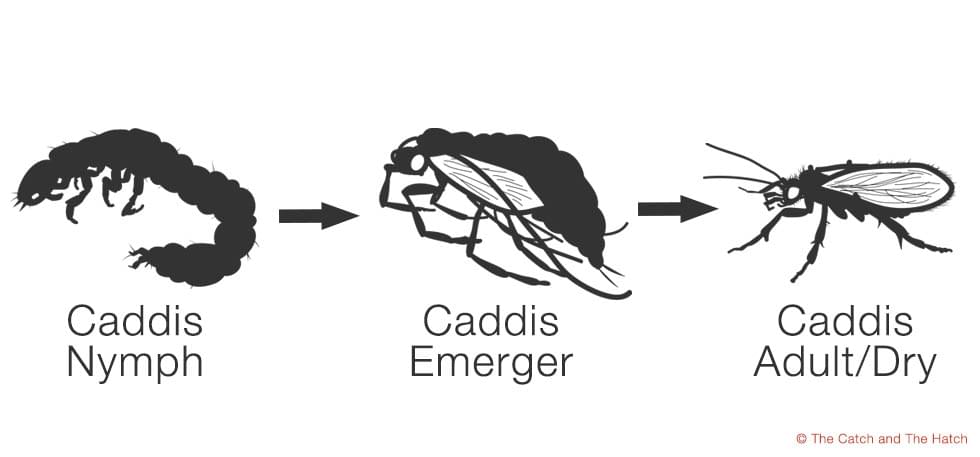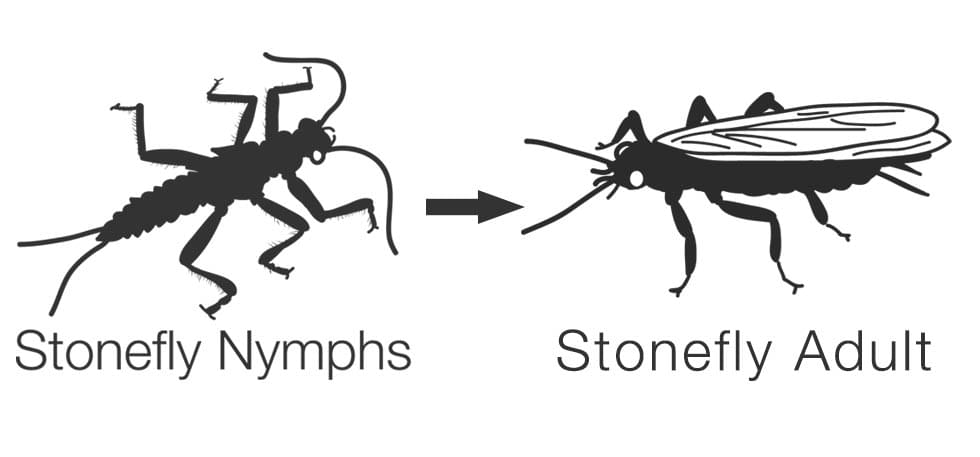3 Indispensable Skills for Trout Fly Selection
The Hard Truth About Fly Selection
Without good fly selection, the best gear, perfect cast, and hard earned time and money to get on the river is wasted on a zero fish day. Most of us don’t get to fish everyday. Getting out on the river then, is an adventure you don’t want to waste because you couldn’t figure out the right fly to throw to those picky rising trout.
Fly selection is an indispensable skill on the water. You need to know what bugs to throw that will catch fish. This is not easy and is often why hiring a guide is essential, especially in unfamiliar waters. However, if you follow our 3 principles to trout fly selection, you will catch more fish. It’s a simple fact that with the right knowledge, observation and preparation, your fly selection will improve and you will hook more fish.
The Truth About Fly Selection
No one wants to say it, but I will: Fly selection is nothing more than guess work. Too many factors go into what makes a fish eat a fly that it really is just a guessing game. The really good anglers, are just good at guessing. To guess well, requires knowledge, selection, observation, and luck.
It’s just a process of elimination. This article will break it down for you and give you the tools you need to guess better and faster. When you guess right…you’ll know it.
Here are 3, easy to remember and follow tips to drastically improve your fly selection
Fly Selection Cheat Sheet
Don’t want to read this whole post or have a good foundation to begin with? Great, here’s how you should approach it. It’s all about process of elimination and following 4 quick steps:
- Identify the Stage of the Insect: What stage are the insects in that the fish are eating? This will roughly divide your box into 3rds and allow you to drill down with more accuracy.
- Identify the Color and Size of the Insect: Even if you don’t know the name, at least getting the color, profile and size right will probably get the job done on the simpler waters to fish. Those 2 steps alone, get you down to likely only a dozen or so patterns.
- Choose the Fly with the Best Presentation for the Setting: A bit ambigous, but what I mean here is to look at the flow of the water, the depth of the feeding fish, and ask yourself what is going to get the fly in front of the fish in the most natural way possible so it pays attention to the fly and decides to eat it? Whatever pattern that is, well that’s your guy. Tie it on.
- Let it Hunt: Once you’ve chosen the fly with the above 3 steps, let the fly hunt. This means fish it for a sufficient amount of time to where you are confident that if it is the right fly, the fish would have eaten it by now. Fish it through a solid run, riffle and hole, againts the banks, and under that low hanging tree. change depths and weight a few times and then if they fish don’t eat, it’s time to choose a different fly from your narrowed selection.
There ya go you lazy bums, it’s the quick and easy solution to fly selection. However, if you want to be as good as the guides and outfish your friends, you’d best read on….
Learn Your Bugs – Knowledge
“Hey man, what are they eating?”
“Um…those little green things with the wispy tails and the squirmy eyes…..”
If you’re new to fly fishing, or never taken the time to really learn the bugs, you can resonate with the conversation above. You may be able to see what they are eating, but you have no idea what they are called, and what that means for the fishing. If you knew that the little green things with wispy tails and squirmy eyes were called blue wing olives and that they are a type of mayfly that hatches mid morning to late afternoon, often year round, and that a CDC Baetis Student or a BWO barr’s emerger would imitate those bugs, then you would be able to greatly improve your chances to catch fish. Consider for a moment what happens when you see a hatch, but the fish aren’t rising to those bugs? Ever wonder what is going on? It’s very likely the fish are eating the nymphs or the emergers of that hatched insect. If you can identify it’s a Blue wing olive, then you can easily grab that mercury baetis in your box and tie it on 36 inches below your indicator with no split shot and start hooking up immediately. Without this knowledge, you’re forced to guess from a huge selection of possible flies & that just doesn’t cut it. There are too many options to choose.
Knowledge is key, so let’s break it down on what key knowledge you need to improve your fly selection.
Understand Insect Stages
Understanding the stages that insects can be in is critical when it comes time to identifying what’s going on in the water. It’s all about process of elimination with fly selection and if you can elminate bugs by stages, you can divide your box into thirds. You may not know the green thing is a baetis, but you know its a nymph and that cuts out half your fly box already. If you know it’s a nymph, you know not to throw something on top of the water and something likely with a beadhead or weight. Understanding insect stages will eliminate a variety of flies not to use and give you good odds to catch more fish.
Let’s keep this simple. Nearly every bug has these 3 stages: Nymph, Emerger, Dry. Let’s break down and define these 3 stages for you to remember when you’re on the water and when you are identifying insects or fly patterns. We’ll define 2 other stages as well, but they are far less important to the first 3.
- Midge Lifecycle
- Mayfly Lifecycle
- Caddis Lifecycle
- Stonefly Lifecycle
Get More Free Guides
Delivered Weekly to Your Inbox
- Nymph Fly – a nymph is under the water and is the stage of the insect where they have not yet hatched. Nymphs are what you fish under an indicator and often are weighted to get down to the bottom of the river where fish feed on nymphs. It’s estimated that fish feed 90% of their diet off sub-surface (nymphs) insects. No doubt this is an important stage to understand.
- Emerger Fly – an emerger is the transformation stage between a nymph and a dry (adult) fly. This is when a bug is most vunerable to being eaten, and trout really pay attention to these. You would be wise to pay attention as well.
- Dry Fly – a dry fly is the adult stage and is the stage you can visibly see. These are above the water’s surface and fly around mating, feeding and laying eggs. This is the most well known stage because it’s easy to see.
- Pupa Fly – for bugs that experience complete metamorphasis, they go through a pupa stage. The only bug you need to know for fly fishing that goes to a pupa stage is a caddis. Think of this like a cocoon the bug goes through underwater before it emergers and then hatches.
- Spinner Fly – A spinner fly is an adult that is either laying eggs or has died and lays spent, often wings layed out on the waters surface, waiting to be eaten. They are helpless, lifeless, and from what the trout tell me, fairly delicious.
Know these 5 stages and then visit our fly shop section of the site. These 5 stages are outlined on each and every pattern, giving you insight into which patterns imitate which stages.
Understand Insect Orders
Forget the latin names, and studying the entomology and species and classes of insects. Unless your a bug nut, you just don’t need to know it to catch more fish. What you need to know is if an insect is a Mayfly, Caddis, Midge, Stonefly, or something else. 80% or more of a trout’s diet is on those “orders” of bugs. An order is the way scientists classify bugs and other animals in the world (see wiki here). Regardless, if you can identify that it’s a mayfly nymph, or a caddis emerger, or a stonefly dry, you’re well on your way to finding a pattern that imitates that bug.
If you want to better understand insect orders, refer to or check out our basic entomology for fly fishing course.
Understand Fly Pattern Names
Great! You are on the water and you can tell that the BWO Dry flies are coming off. What now? You look at your box and get utterly confused again. You foolishly grab an olive elk hair caddis (CADDIS!!!!) and shrug and say, “It’s a dry fly and its olive and it’s worked in the past. why not now?” Cause it’s a caddis…. that’s why.
I can’t stress this enough, you need to know the names of the flies and the order and stage they imitate. Without it all the previous knowledge is wasted. Our site and fly shop here, shows each bug by stage and order for you to better understand what flies you are buying and what they are imitating. Some flies imitate a variety of insects, others, very specific insects only. Spend some time learning the names and you’ll be much better off. If that’s not enough, you’ll be the pro on the water next time with your friends when you can tell them that’s a neverbug or a sparkle dun CDC BWO, and actually be right and know what it imitates.
A final tip on learning the names of flies. Tyers name a fly 4 ways. Knowing how they name it helps you understand and more easily remember the fly name. They name it after the bug it imitates, after the materials used, the tyers last name itself or after the bottle of whisky they drank to tie the fly. Sometimes all four. Good examples are the elk hair caddis. It imitates a caddis and is tied with an elk hair wing. The Barrs emerger, is named after the creator of the fly, John Barr. The neverbug is my creation and is named because you never get tired of fishing it. (Yes alcohol was a precursor to the naming of that fly, but it was rum, not whisky :). A CDC Biot Sparkle Dun is tied with CDC, Biot goose feathers and sparkle hackle and imitates an adult (or dun) fly. Knowing tying materials helps this process as well, but isn’t essential. Don’t EVER ask me how the Sex Dungeon streamer got it’s name…




